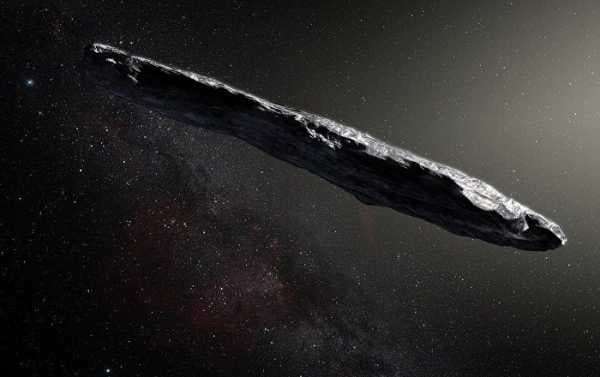
The first discovered interstellar visitor to enter our solar system, the huge, hurtling rock known as ‘Oumuamua, has been spinning chaotically for many billions of years, according to scientists.
The cigar-shaped object that wandered into our solar system in October was found not to be evidence of alien life — to the dismay of many — but rather just an oddly shaped rock zooming through space. Researchers initially believed that the object was an asteroid, but were puzzled to discover that it has an icy interior and spins in a way not typical of asteroids.
Since October, a team of international researchers from Queen’s University Belfast’s School of Mathematics and Physics, the Academy of Sciences of the Czech Republic, the University of Belgrade and the Open University of England have been studying brightness measurements from the interstellar object. They recently published their findings in the Nature Astronomy journal.
The researchers concluded that “Oumuamua isn’t spinning periodically like many asteroids in our solar system. Instead, the object is spinning frantically while reorienting itself, and it could have been for billions of years.”
Although scientists do not yet understand the cause of the tumbling, they believe that it may have been caused by “Oumuamua colliding with another asteroid, propelling it out into interstellar space.”
“Our modeling of this body suggests the tumbling will last for many billions of years to hundreds of billions of years before internal stresses cause it to rotate normally again,” said Dr. Wes Fraser of Queen’s University Belfast’s School of Mathematics and Physics.
“While we don’t know the cause of the tumbling, we predict that it was most likely sent tumbling by an impact with another planetesimal in its system, before it was ejected into interstellar space.”
Scientists are also perplexed as to why the object appears mostly red when it faces telescopes on Earth while the rest of it maintains a neutral color.
“Most of the surface reflects neutrally but one of its long faces has a large red region. This argues for broad compositional variations, which is unusual for such a small body,” Fraser explained, physics.org reported.
“We now know that beyond its unusual elongated shape, this space cucumber had origins around another star, has had a violent past and tumbles chaotically because of it. Our results are really helping to paint a more complete picture of this strange interstellar interloper. It is quite unusual compared to most asteroids and comets we see in our own solar system,” Fraser added.
Sourse: sputniknews.com






